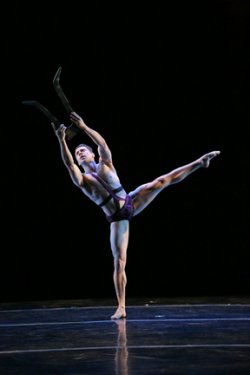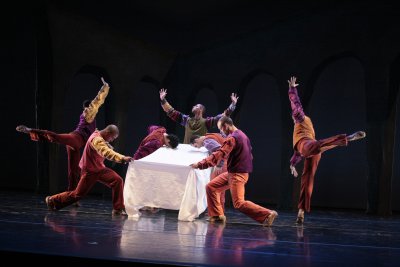José Limón International Dance Festival
A fascinating look at the work of a seminal modern dance maker.
[avatar user=”Joel Benjamin” size=”96″ align=”left” ] Joel Benjamin, Critic[/avatar] The Limón Dance Company celebrated its 70th Anniversary by presenting the José Limón International Dance Festival at the Joyce Theater. The Limón dancers joined forces with several other companies in six programs of works by this master modern dance choreographer who died in 1972. His legacy has been tended to by subsequent generations of dancers, directed since 1978 by the indefatigable Carla Maxwell who was herself a pre-eminent Limón interpreter.
The guest in this program was Terry Springer of Coreoarte who danced Limón’s “Chaconne,” to music by J.S. Bach. This 1942 solo work is a stately response to the Violin Partita. The dancer, dressed in a formal-looking black outfit, moves slowly in movements that combined ballet, wide, curved gestures, a touch of flamenco and even a smidgen of toreador moves. It’s difficult to pull off because the dancer is totally exposed and has to make the slow-motion choreography constantly interesting. Mr. Springer was technically fine, but a tad bland. He missed the austere grandness, but clearly will put his stamp on this work soon.

Aaron Selissen as Orfeo and Ryoko Kudo as Eurydice in the José Limón’s ballet “Orfeo” ((Photo credit: Beatriz Schiller)
“Orfeo” (1971) to a turbulent Beethoven String Quartet is an efficient and moving retelling the of the Orpheus and Eurydice myth. Orfeo (Aaron Selissen) is first seen with his lyre agonizing over the loss of his beloved Eurydice (Ryoko Kudo) who appears, veiled and somber, accompanied by three Guardians of the Dead (Logan Kruger, Kathryn Alter and Brenna Monroe-Cook). Limón’s clever and telling movements keep the two lovers from facing each other until the very end. Orfeo’s glance acts like a punch and poor Eurydice retreats, pulled by her guides, back to the netherworld. The movements are slow and lyrical with some jagged arm and head movements to indicate the aching sense of loss and the frustration of not being able to touch. This was a beautifully danced version of this tale as interpreted by a mature artist.
“Dances for Isadora” (1971) to Chopin, played live by the terrific Michael Cherry, is one of those hybrids—a meeting of creative minds—that enhances all concerned. Here Limón is influenced by the graceful, free-flowing style of the extraordinarily influential Isadora Duncan, freeing him to find new movements to express the lightness and darkness of his subject. Duncan’s drama-filled story is the jumping off point for this ballet: five solos that are an abstraction of the emotional arc of Duncan’s tumultuous life. From the swift, light-footed “Primavera” danced with great lightness by Kristen Foote to the totally worn out, mature Duncan of the “Scarf Dance” (exquisitely portrayed by Roxane D’Orleans Juste), Limón captures it all in movement, helped by Charles D. Tomlinson’s colorful variations on Duncan’s favorite costume, the Greek tunic. Ryoko Kudo was sensual as the “Maenad” and Kathryn Alter got the subdued anger of “Niobe.” Logan Kruger was elegant and strong as “La Patrie” which echoed Duncan’s time in crisis-plagued revolutionary Russia. This was, for me, the highlight of the program: eloquently assembled movements interpreted by talented dancers actually communicating emotions. What an idea!
“The Traitor” is Limón’s heavy-handed version of the Christ story in which the Leader (a far too bland, but stalwart Mark Willis) is betrayed by the title character (Francisco Ruvalcaba, poignant in his Iago-like treachery). Even the music, Gunther Schuller’s “Symphony for Brass and Percussion,” is tough going. Paul Trautvetter’s set of repeated Roman arches and Pauline Lawrence’s simple, loose peasant costumes, help create a microcosm of worship and pain. There is a clever use of a white table cloth, held by four dancers, to mimic the dining table at the very obvious take on the Last Supper which included the requisite kiss of death. Limón’s choreography is full of his most masculine stomps, twists and jumps and calls upon his all-male cast’s acting talents to tell this story as freshly as is possible.
These four works were an eloquent illustration of the range and humanity of Jose Limón and the dedication of these extraordinary dancers. That some have aged better than others should come as no surprise. The Company does perform works by other choreographers even as it strives to preserve and disseminate José Limón’s rich repertory.
José Limón International Dance Festival (October 13-25, 2015)
Joyce Theatre, 175 Eighth Avenue, in Manhattan
For tickets, call 212-22-0800 or visit http://www.joyce.org
Running time: One hour and 45 minutes including one intermission









Leave a comment